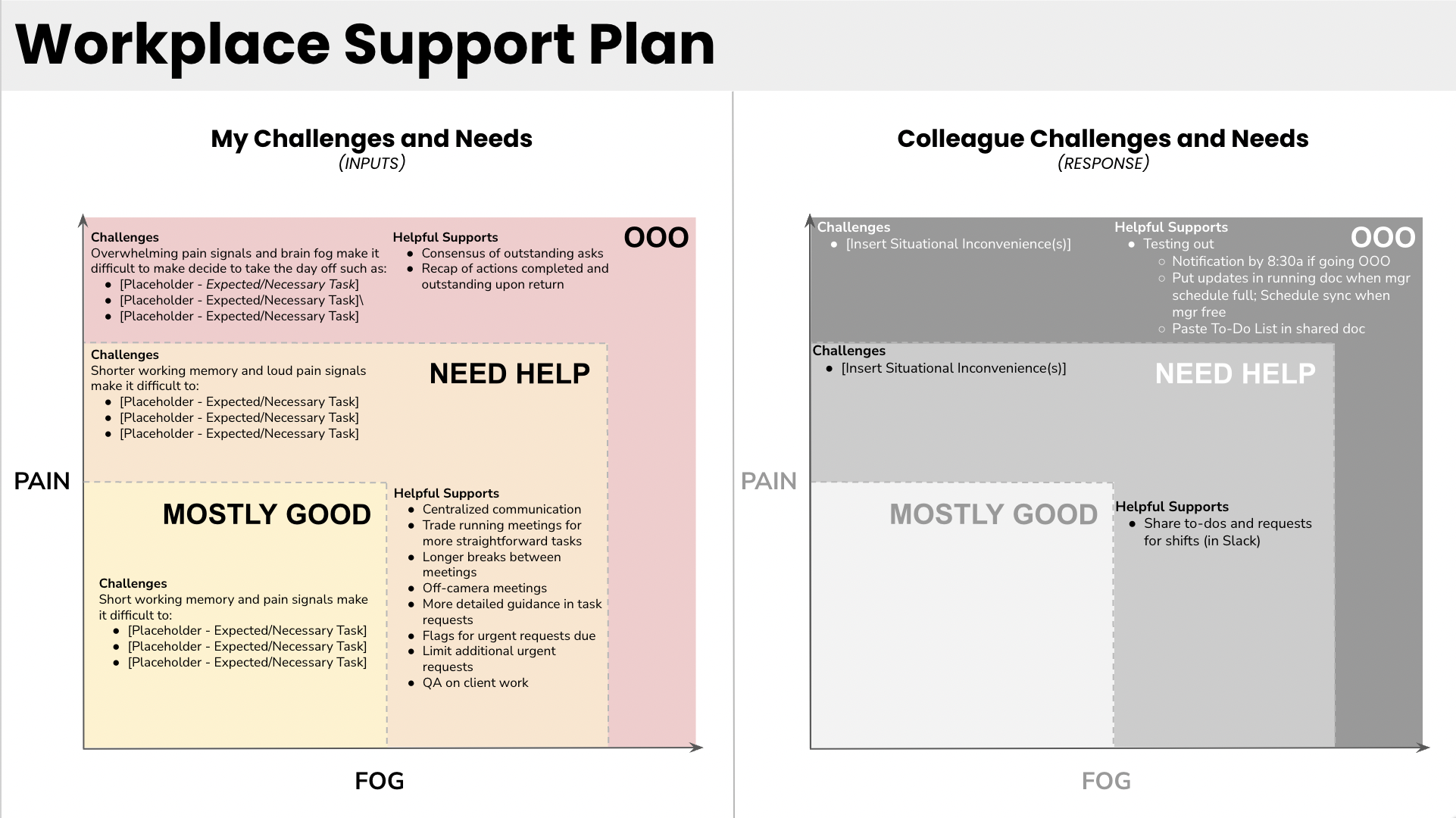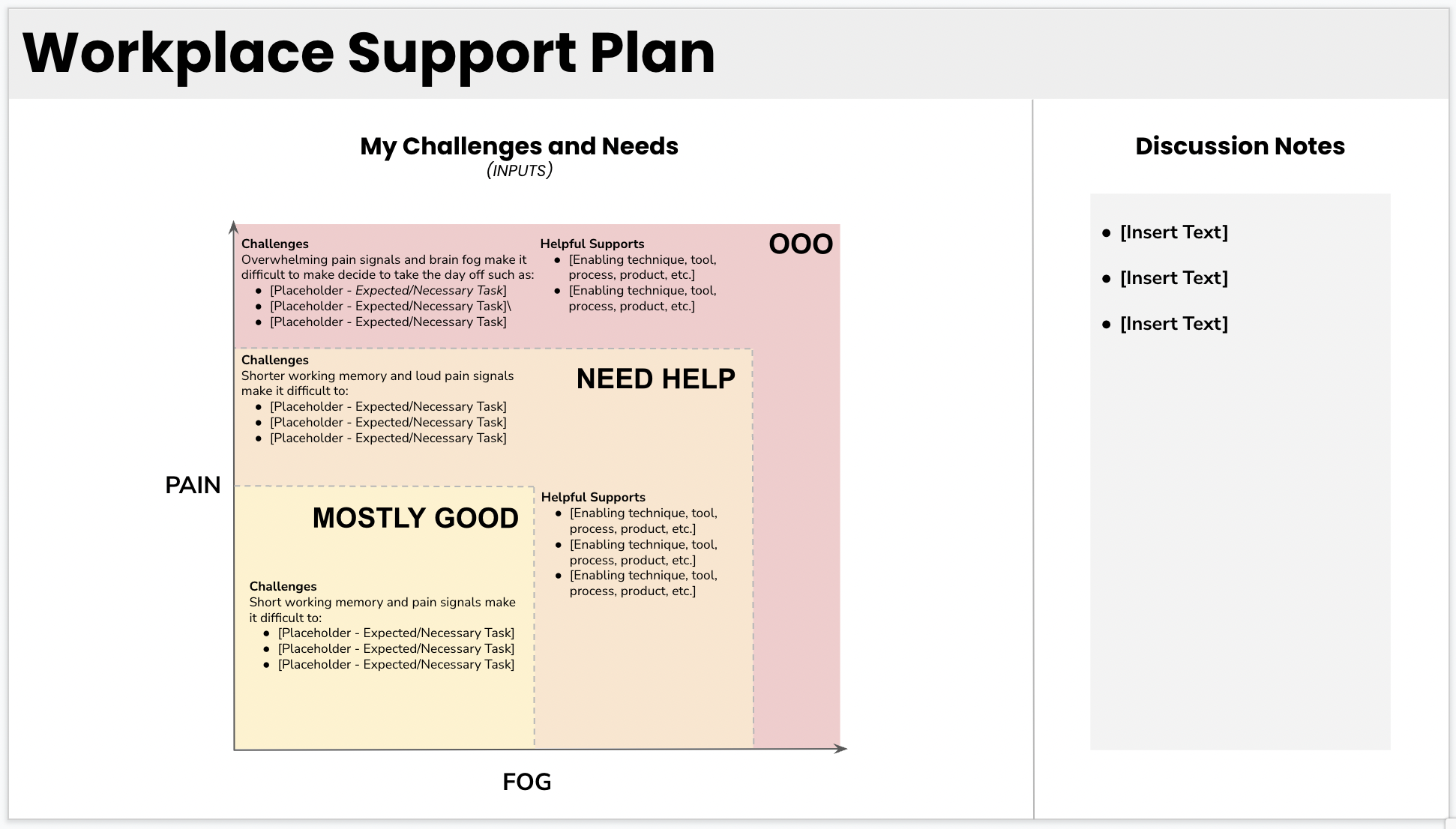Disability Self-Advocacy Tool:
Workplace Support Plan Worksheet
IMPACT PARTNER(S)
Personal Use;
Employer (Size = 1,000 - 5,000 employees)
IMPACT AREA(S)
Employee Experience + Inclusion;
Disability Justice + Self-Advocacy
PROVIDED EXPERTISE
Inclusion Consulting + Strategy;
Accessibility Consulting + Advocacy;
User Experience Design;
Graphic Design
PROJECT DURATION
1 Week (2021)
CHALLENGE
Communicating your needs isn’t the easiest for anyone to do. Adding the layer of the ‘Disability’ identity, tends to make that even more difficult - especially in the workplace.
I live with chronic health conditions that can impact me differently day-to-day, hour-to-hour, and even minute-to-minute. I knew my abilities had a broad range, but I didn’t always know what to ask for in the moment, or worried about how to communicate them in the ‘right way’ to the people who depended on my productivity.
OPPORTUNITY
After a few months of dealing with the anxiety of crafting Slack messages to my manager to explain my health situation for the day, I recognized I needed a tool to help with the anxiety and communication burden that always sat with me.
I needed to design a process to remove some of the thinking about and explaining of my health status each day that made me so anxious.
APPROACH
Before I could create a tool to help communicate my health status and needs, I had to define my health status and needs. I started by brainstorming all of the challenges I experience .
As I suspected, the health challenges I noted aligned with one of two buckets of symptoms - body pain and brain fog. I am never free of these symptoms, and a sudden increase in either can take me out for hours, days, or weeks. I wanted to reflect that in a visual way to more easily communicate my experience during my conversation with my manager.
I landed on the below template, grouping my challenges based upon if I can continue working when experiencing them or not - creating the health status buckets ‘Mostly Good’, ‘Need Help’ and ‘OOO’ (for Out of Office).
Image Above: Workplace Support Plan Worksheet Template
After defining the health status categories, it was time to define the supports I needed meet each challenge. This was the hardest part! I realized I felt nervous about asking for support and writing it down. I imagined asking for these things from my manager and possibly getting pushback - envisioning the things I need being “‘too much”. After defining and inputting my challenges and needs, I reflected more about how I’d facilitate the discussion. Imagining how my manager might respond made me realize that there was still information missing in the template - understanding and capturing the parallel situational challenges and support needs of my manager based on my health status.
Following updates to the template to create a parallel section for my colleague/manager’s responses, it was time to test out the discussion template with my manager.
OUTCOME(S)
Facilitated discussion with Manager:
Talked through how my disabling symptoms impact me in the workplace and how my manager and organization might support my needs to allow my productivity
Updated Colleague portion with inputs from manager
Implemented process into routine
E.g., Sending a message to my manager via Slack to share my status (Mostly Good, Need Help, OOO) and follow the support plan we defined together
Shared with Disability Employee Resource Group(s)
Managers with disabilities in the ERG commented that the worksheet I developed would be a helpful resource to facilitate discussion with their direct reports
NEXT STEPS:
I created this resource to quickly address my needs in a way that was accessible for me and my manager. I also decided to share with others in the ERG community given previous discussion that identified others might also have an immediate need for a support plan. Before distributing more broadly, I would like to update this resource to meet common accessibility needs such as optimized color contrast, Real form fields, clear facilitation instructions, sample responses, an FAQ, etc…

